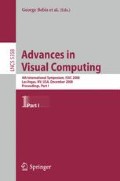Abstract
This paper presents an effective algorithm to segment color video into shots for video indexing or retrieval applications. This work adds global texture information to our previous work, which extended the scale-invariant feature transform (SIFT) to color global texture SIFT (CGSIFT). Fibonacci lattice-quantization is used to quantize the image and extract five color features for each region of the image using a symmetrical template. Then, in each region of the image partitioned by the template, the entropy and energy of a co-occurrence matrix are calculated as the texture features. With these global color and texture features, we adopt clustering ensembles to segment video shots. Experimental results show that the additional texture features allow the proposed CGTSIFT algorithm to outperform our previous work, fuzzy-c means, and SOM-based shot detection methods.
Access this chapter
Tax calculation will be finalised at checkout
Purchases are for personal use only
Preview
Unable to display preview. Download preview PDF.
References
Li, Y., Kuo, C.J.: Video Content Analysis Using Multimodal Information: For Movie Content Extraction. In: Indexing and Representation. Kluwer Academic Publishers, Dordrecht (2003)
Liu, T., Katpelly, R.: Content-Adaptive Video Summarization Combining Queueing and Clustering. In: IEEE International Conference on Image Processing, pp. 145–148 (2006)
Mezaris, V., Kompatsiaris, I., Boulgouris, N.V., Strintzis, M.G.: Real-Time Compressed-Domain Spatiotemporal Segmentation and Ontologies for Video Indexing and Retrieval. IEEE Transactions on Circuits and Systems for Video Technology 14(5), 606–621 (2004)
Koskela, M., Smeaton, A.F.: Clustering-Based Analysis of Semantic Concept Models for Video Shots. In: International Conference on Multimedia and Expo., pp. 45–48 (2006)
Lo, C.C., Wang, S.J.: Video Segmentation Using A Histogram-Based Fuzzy C-Means Clustering Algorithm. In: International Conference on Fuzzy Systems, vol. 2, pp. 920–923 (2001)
O’Connor, N., Cziriek, C., Deasy, S., Marlow, S., Murphy, N., Smeaton, A.: News Story Segmentation in the Fischlar Video Indexing System. In: IEEE International Conference on Image Processing (2001)
Rui, Y., Huang, T.S., Mehrotra, S.: Constructing Table-of-Content for Videos. Multimedia Systems 7, 359–368 (1999)
Chang, Y.C., Lee, D.J., Hong, Y., Archibald, J.K.: Unsupervised Video Shot Detection Using Clustering Ensemble with a Color Global Scale-Invariant Feature Transform Descriptor. Color in Image and Video Processing of the EURASIP Journal on Image and Video Processing 2008, Article ID 860743, 10 pages (February 2008)
Lowe, D.G.: Distinctive Image Feature from Scale-Invariant Keypoints. International Journal of Computer Vision 60, 91–110 (2004)
Lowe, D.G.: Object Recognition from Local Scale-Invariant Features. In: International Conference on Computer Vision, vol. 2, pp. 1150–1157 (1999)
Strehl, A., Ghosh, J.: Cluster Ensembles – A Knowledge Reuse Framework for Combining Multiple Partitions. Journal of Machine Learning Research (3), 583–617 (2002)
Kuncheva, L.I., Vetrov, D.P.: Evaluation of Stability of K-Means Cluster Ensembles with Respect to Random Initialization. IEEE Transactions on Pattern Analysis and Machine Intelligence 28(11), 1798–1808 (2006)
Mojsilovic, A., Soljanin, E.: Color Quantization and Processing by Fibonacci Lattices. IEEE Transactions on Image Processing 10, 1712–1725 (2001)
Haralick, R.M., Shanmugam, K., Distein, I.: Textural Features for Image Classification. IEEE Transactions on Systems, Man and Cybernetics 3(6), 610–621 (1973)
Open Video Project, http://www.open-video.org/index.php
Berkhin, P.: Survey of Clustering Mining Techniques, Accrue Software Inc., Technical Report (2002)
Mikolajczyk, K., Schmid, C.: A Performance Evaluation of Local Descriptors. IEEE Transactions on Pattern Analysis and Machine Intelligence 27(10), 1615–1630 (2005)
Author information
Authors and Affiliations
Editor information
Editors and Affiliations
Rights and permissions
Copyright information
© 2008 Springer-Verlag Berlin Heidelberg
About this paper
Cite this paper
Chang, Y., Lee, DJ., Hong, Y., Archibald, J. (2008). Unsupervised Video Shot Segmentation Using Global Color and Texture Information. In: Bebis, G., et al. Advances in Visual Computing. ISVC 2008. Lecture Notes in Computer Science, vol 5358. Springer, Berlin, Heidelberg. https://doi.org/10.1007/978-3-540-89639-5_44
Download citation
DOI: https://doi.org/10.1007/978-3-540-89639-5_44
Publisher Name: Springer, Berlin, Heidelberg
Print ISBN: 978-3-540-89638-8
Online ISBN: 978-3-540-89639-5
eBook Packages: Computer ScienceComputer Science (R0)

